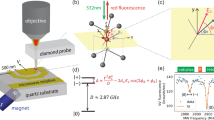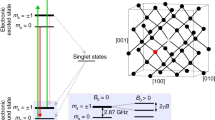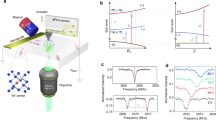Abstract
The nitrogen-vacancy defect centre in diamond1,2,3,4 has potential applications in nanoscale electric and magnetic-field sensing2,3,4,5,6, single-photon microscopy7,8, quantum information processing9 and bioimaging10. These applications rely on the ability to position a single nitrogen-vacancy centre within a few nanometres of a sample, and then scan it across the sample surface, while preserving the centre's spin coherence and readout fidelity. However, existing scanning techniques, which use a single diamond nanocrystal grafted onto the tip of a scanning probe microscope2,8,11,12, suffer from short spin coherence times due to poor crystal quality, and from inefficient far-field collection of the fluorescence from the nitrogen-vacancy centre. Here, we demonstrate a robust method for scanning a single nitrogen-vacancy centre within tens of nanometres from a sample surface that addresses both of these concerns. This is achieved by positioning a single nitrogen-vacancy centre at the end of a high-purity diamond nanopillar, which we use as the tip of an atomic force microscope. Our approach ensures long nitrogen-vacancy spin coherence times (∼75 µs), enhanced nitrogen-vacancy collection efficiencies due to waveguiding, and mechanical robustness of the device (several weeks of scanning time). We are able to image magnetic domains with widths of 25 nm, and demonstrate a magnetic field sensitivity of 56 nT Hz–1/2 at a frequency of 33 kHz, which is unprecedented for scanning nitrogen-vacancy centres.
This is a preview of subscription content, access via your institution
Access options
Subscribe to this journal
Receive 12 print issues and online access
$259.00 per year
only $21.58 per issue
Buy this article
- Purchase on Springer Link
- Instant access to full article PDF
Prices may be subject to local taxes which are calculated during checkout




Similar content being viewed by others
References
Chernobrod, B. M. & Berman, G. P. Spin microscope based on optically detected magnetic resonance. J. Appl. Phys. 97, 014903 (2005).
Balasubramanian, G. et al. Nanoscale imaging magnetometry with diamond spins under ambient conditions. Nature 455, 648–651 (2008).
Maze, J. R. et al. Nanoscale magnetic sensing with an individual electronic spin in diamond. Nature 455, 644–647 (2008).
Taylor, J. et al. High-sensitivity diamond magnetometer with nanoscale resolution. Nature Phys. 4, 810–816 (2008).
Dolde, F. et al. Electric-field sensing using single diamond spins. Nature Phys. 7, 459–463 (2011).
Degen, C. L. Scanning magnetic field microscope with a diamond single-spin sensor. Appl. Phys. Lett. 92, 243111 (2008).
Sekatskii, S. & Letokhov, V. Nanometer-resolution scanning optical microscope with resonance excitation of the fluorescence of the samples from a single-atom excited center. JETP Lett. 63, 319–323 (1996).
Cuche, A. et al. Near-field optical microscopy with a nanodiamond-based single-photon tip. Opt. Express 17, 19969–19980 (2009).
Neumann, P. et al. Quantum register based on coupled electron spins in a room-temperature solid. Nature Phys. 6, 249–253 (2010).
McGuinness, L. P. et al. Quantum measurement and orientation tracking of fluorescent nanodiamonds inside living cells. Nature Nanotech. 6, 358–363 (2011).
Kuhn, S., Hettich, C., Schmitt, C., Poizat, J. & Sandoghdar, V. Diamond colour centres as a nanoscopic light source for scanning near-field optical microscopy. J. Microsc. 202, 2–6 (2001).
Rondin, L. et al. Nanoscale magnetic field mapping with a single spin scanning probe magnetometer. Appl. Phys. Lett. (in the press).
Kurtsiefer, C., Mayer, S., Zarda, P. & Weinfurter, H. Stable solid-state source of single photons. Phys. Rev. Lett. 85, 290–293 (2000).
Balasubramanian, G. et al. Ultralong spin coherence time in isotopically engineered diamond. Nature Mater. 8, 383–387 (2009).
Gruber, A. et al. Scanning confocal optical microscopy and magnetic resonance on single defect centers. Science 276, 2012–2014 (1997).
Michaelis, J., Hettich, C., Mlynek, J. & Sandoghdar, V. Optical microscopy using a single-molecule light source. Nature 405, 325–328 (2000).
Kalish, R. et al. Nitrogen doping of diamond by ion implantation. Diamond Relat. Mater. 6, 516–520 (1997).
Babinec, T. M. et al. A diamond nanowire single-photon source. Nature Nanotech. 5, 195–199 (2010).
Hausmann, B. J. et al. Fabrication of diamond nanowires for quantum information processing applications. Diamond Relat. Mater. 19, 621–629 (2010).
Jelezko, F., Gaebel, T., Popa, I., Gruber, A. & Wrachtrup, J. Observation of coherent oscillations in a single electron spin. Phys. Rev. Lett. 92, 076401 (2004).
Van Oort, E. & Glasbeek, M. Optically detected low field electron spin echo envelope modulations of fluorescent N-V centers in diamond. Chem. Phys. 143, 131–140 (1990).
De Lange, G., Ristè, D., Dobrovitski, V. V. & Hanson, R. Single-spin magnetometry with multipulse sensing sequences. Phys. Rev. Lett. 106, 080802 (2011).
Dreau, A. et al. Avoiding power broadening in optically detected magnetic resonance of single NV defects for enhanced dc magnetic field sensitivity. Phys. Rev. B 84, 195204 (2011).
Grinolds, M. S. et al. Quantum control of proximal spins using nanoscale magnetic resonance imaging. Nature Phys. 7, 687–692 (2011).
Lai, N., Zheng, D., Jelezko, F., Treussart, F. & Roch, J-F. Influence of a static magnetic field on the photoluminescence of an ensemble of nitrogen-vacancy color centers in a diamond single-crystal. Appl. Phys. Lett. 95, 133101 (2009).
Buchler, B. C., Kalkbrenner, T., Hettich, C. & Sandoghdar, V. Measuring the quantum efficiency of the optical emission of single radiating dipoles using a scanning mirror. Phys. Rev. Lett. 95, 063003 (2005).
Bradac, C. et al. Observation and control of blinking nitrogen-vacancy centres in discrete nanodiamonds. Nature Nanotech. 5, 345–349 (2010).
Pezzagna, S. et al. Nanoscale engineering and optical addressing of single spins in diamond. Small 6, 2117–2121 (2010).
Naydenov, B. et al. Increasing the coherence time of single electron spins in diamond by high temperature annealing. Appl. Phys. Lett. 97, 242511 (2010).
Wolny, F. et al. Iron filled carbon nanotubes as novel monopole-like sensors for quantitative magnetic force microscopy. Nanotechnology 21, 435501 (2010).
Kohashi, T., Konoto, M. & Koike, K. High-resolution spin-polarized scanning electron microscopy (spin SEM). J. Electron Microsc. 59, 43–52 (2010).
Kane, B. E. A silicon-based nuclear spin quantum computer. Nature 393, 133–137 (1998).
Recher, P. & Trauzettel, B. Quantum dots and spin qubits in graphene. Nanotechnology 21, 302001 (2010).
Togan, E. et al. Quantum entanglement between an optical photon and a solid-state spin qubit. Nature 466, 730–734 (2010).
Lee, C., Gu, E., Dawson, M., Friel, I. & Scarsbrook, G. Etching and micro-optics fabrication in diamond using chlorine-based inductively-coupled plasma. Diamond Relat. Mater. 17, 1292–1296 (2008).
Childress, L. et al. Coherent dynamics of coupled electron and nuclear spin qubits in diamond. Science 314, 281–285 (2006).
Acknowledgements
The authors thank B.D. Terris and N. Supper from Hitachi GST for providing the magnetic recording samples. P.M. acknowledges support from the Swiss National Science Foundation and S.H. thanks the Kwanjeong Scholarship Foundation for funding. M.S.G. is supported by fellowships from the Department of Defense (NDSEG programme) and the National Science Foundation (NSF). This work was supported by NIST and DARPA QuEST and QuASAR programmes and in part was performed at the Center for Nanoscale Systems (CNS), a member of the National Nanotechnology Infrastructure Network (NNIN), which is supported by the NSF (under award no. ECS–0335765). CNS is part of Harvard University.
Author information
Authors and Affiliations
Contributions
All authors contributed to all aspects of this work.
Corresponding author
Ethics declarations
Competing interests
The authors declare no competing financial interests.
Supplementary information
Supplementary information
Supplementary information (PDF 672 kb)
Rights and permissions
About this article
Cite this article
Maletinsky, P., Hong, S., Grinolds, M. et al. A robust scanning diamond sensor for nanoscale imaging with single nitrogen-vacancy centres. Nature Nanotech 7, 320–324 (2012). https://doi.org/10.1038/nnano.2012.50
Received:
Accepted:
Published:
Issue Date:
DOI: https://doi.org/10.1038/nnano.2012.50
This article is cited by
-
Nitrogen-vacancy magnetometry of CrSBr by diamond membrane transfer
npj 2D Materials and Applications (2023)
-
Quantum sensors for biomedical applications
Nature Reviews Physics (2023)
-
Flux focusing with a superconducting nanoneedle for scanning SQUID susceptometry
Microsystems & Nanoengineering (2023)
-
Magnetometry of neurons using a superconducting qubit
Communications Physics (2023)
-
Perspective: nanoscale electric sensing and imaging based on quantum sensors
Quantum Frontiers (2023)



